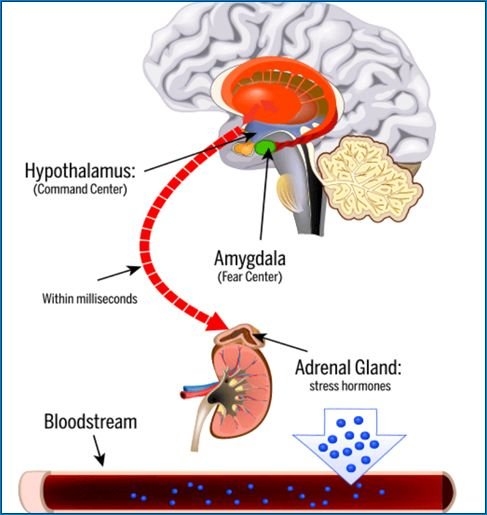The Anatomy Of A panic Attack
The Anatomy Of A Panic Attack
Panic attacks are real, normal body reactions or coping mechanisms to different stressors or distressing predicaments. Panic attacks trigger the chemical, physical, and emotional reactions of the body that are elicited by fear, apprehension, or shock.
Those who experience panic attacks have reported light-headedness, chest pain, hot flashes, chills, and stomach discomfort. Some say they feel like they were being choked or suffocated. Others say an attack made them feel “detached from reality.”
Panic attacks cause a “fight or flight” response. The body automatically reacts to stress or stress-inducing activities by either making a confrontational stance or deciding to avoid stress.
o Panic attacks can be frightening and happen suddenly.
o They are not rooted in real events and often can appear for no clear reason.
o You may have one or more panic attacks during your life, or you may never have one.
o During a panic attack you feel consumed by fear and may even think you’re dying, even though you’re really in no danger.
o You may feel a rush of intense anxiety and physical symptoms.
o Your heart is pounding and you may feel that you can’t catch your breath.
Feelings and sensations associated with panic attacks.
A panic attack means you have four or more of these symptoms:
• Pounding heart
• Chest Pain
• Sensation of rush through the body
• Shortness of breath
• Chills or hot flashes
• Feeling like you’re losing control or going crazy
• Trembling or shaking
• Nausea
• Dizziness
• Sweating
• An out-of-body sensation
• Like you’re choking
• A fear that you’re dying.
• Tingling or numb hands, arms, feet, or legs
What Happens in Your Brain
Scientists are still studying how panic attacks affect the brain. It’s possible that the parts of the brain that are tied to fear become more active during an episode. One recent study found that people with panic disorder had lots of activity in a part of their brains tied to the “fight or flight” response.
Other studies have found possible links between panic disorder and the chemicals in your brain. The condition may also be linked to an imbalance in serotonin levels, which can affect your moods.
What Happens Inside Your Body
The body’s “fight or flight” response is behind the intense physical symptoms.
Our body however is not that specialized in understanding what threat we are dealing with. Our fear response system is universal and responds in one single way, emulating a physical threat response.
Normally when you encounter a threat – a bear or a lion chasing you -- your nervous system springs into action. The adrenal gland secretes the hormone adrenaline which floods into your bloodstream, putting your body on high alert. As response to the threat, the Sympathetic Nervous System will contribute to creating the following responses:
- Your heartbeat goes faster, and this will send more blood to your muscles. This is why you may your arms and lags muscle contracting, face turns red.
- Your senses get sharper, your pupils dilate which may result in seeing spots or getting a tunnel vision sensation.
- Your hearing reduces this is because the overproduction of adrenaline reduced the blood flow to your auditory system. The sensation of fulness and feeling “weird” is also caused by the fact that your ear cannot reduce pressure.
- Your breathing becomes fast and shallow, so you can take in more oxygen.
- Your blood glucose spikes to prepare your muscles to engage.
- Your perspiration is stimulated so your body can regulate heat while you run / fight / engage your muscles.
- Your digestion is inhibited, and gut blood vessels are constricted; this will cause stomach pain and nausea;
All of these changes -- which happen in an instant -- give you the energy you need to confront a dangerous situation or get out of harm’s way quickly.

Random panic attacks
At times, your fear response can be initiated with no reason. Researchers don’t know exactly what triggers them and this may have to do with the elevated, even exaggerated response to even minor threats. During a panic attack, the adrenaline levels in the body can spike by 2 1/2 times or more. Panic attacks may not come as unexpectedly as they seem. The physical changes may start about an hour before an attack. In one study, people with panic disorder wore devices that tracked their heart activity, sweating, and breathing. The results showed lower-than-normal levels of carbon dioxide, a sign of rapid, deep breathing that can leave you breathless, as early as about 45 minutes before the panic attack.
Difference between Panic Attacks and Anxiety Attacks
Both Panic and Anxiety Attacks are targeting the fear response in the body and have similar symptoms. Panic and Anxiety attacks both cause a rapid heart rate, shallow breathing, and a sense of distress. However, they typically differ in severity and cause.
- Panic attacks are often more intense and can occur with or without a trigger, while anxiety attacks are a response to a perceived threat.
- While panic attacks come on suddenly, anxiety symptoms follow a period of excessive worry. Anxiety symptoms may become more pronounced over a few minutes or hours. They are typically less intense than those of panic attacks.
Because the symptoms are so similar, it can be difficult to distinguish between panic and anxiety attacks.
Panic Attacks
- Typically occur with a trigger but can occur without one.
- Symptoms typically appear suddenly.
- Symptoms are disruptive and may involve a sense of detachment.
- Typically subside after a few minutes.
Anxiety Attacks
- A response to a perceived stressor or threat.
- Feelings of anxiety may build gradually over time.
- Symptoms can vary in intensity from mild to severe.
- Symptoms may prevail for longer periods.
Feelings and sensations associated with anxiety attacks.
Anxiety attacks are not a diagnosable condition. However, symptoms of generalized anxiety disorder (GAD) include:
o nervousness
o irritability
o increased heart rate
o rapid breathing
o trembling
o sweating
o a sense of impending danger
o difficulty concentrating
o sleep disturbances
What causes Panic and Anxiety Attacks?
Anxiety symptoms often last longer than the symptoms of a panic attack. They may persist for days, weeks, or months.
The exact causes of anxiety and panic disorders are unclear. People likely develop these disorders due to a combination of genetic, medical, and external factors.
What You Can Do
To get through a panic or and an anxiety attack, try to take control of your breathing first. Find a place where you can sit or be comfortable. Concentrate on making your breath slow and even. Try to inhale through your nose for 4 seconds, hold it for 2 seconds, then exhale through your mouth for 6 seconds. Tell yourself that you’re not in danger and that the attack will pass. While certain medical emergencies can have similar symptoms to a panic attack, many people mistake a panic attack for a medical emergency, like a heart attack. The symptoms can seem similar, but panic attacks aren’t life-threatening.
If you’re not sure if you’re having a panic attack, it’s a good idea to go to the hospital to rule out any other health problems.
Cognitive Behavioral Therapy (CBT) is an extremely effective treatment for panic and anxiety disorder: about 80% of people with panic disorder who complete a course of CBT are experiencing significant improvements at the end of treatment. CBT is a highly effective method of treatment for anxiety disorders.
Ascent CBT September 13, 2023
testimonials
Cristian's kind and empathetic nature always made me find our sessions a safe and happy place. I gained a new perspective on so many things that had been causing me anxiety by learning about the CBT framework of anxiety”
I have referred many people to York Region CBT - Cristian over the last year and would support anyone any parent who's child is dealing with OCD to make that initial appointment and start working with Cristian.
Cristian is methodical and will take you through the CBT steps without any judgment and drama so soon you will find new ways of looking at things in a different light without changing your personality or things you believe in.



